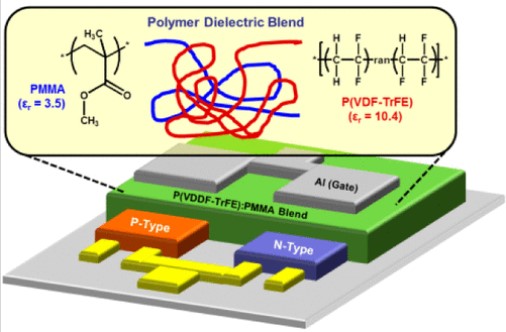Controlled Charge Transport by Polymer Blend Dielectrics in Top-Gate Organic Field-Effect Transistors for Low-Voltage-Operating Complementary Circuits
- 저자
- Kang-Jun Baeg, Dongyoon Khim, Juhwan Kim, Hyun Han, Soon-Won Jung, Tae-Wook Kim, Minji Kang, Antonio Facchetti, Sung-Kyu Hong, Dong-Yu Kim, and Yong-Young Noh.
- 저널명
- ACS Applied Materials & Interfaces, 4, 11, 6176–6184 (2012)
- 년도
- 2012
- Link
- http://dx.doi.org/10.1021/am301793m 573회 연결
[Abstract]
We report here the development of high-performance p- and n-channel organic field-effect transistors (OFETs) and complementary circuits using inkjet-printed semiconducting layers and high-k polymer dielectric blends of poly(vinylidenefluoride-trifluoroethylene) (P(VDF-TrFE)) and poly(methyl methacrylate) (PMMA). Inkjet-printed p-type polymer semiconductors containing alkyl-substituted thienylenevinylene (TV) and dodecylthiophene (PC12TV12T) and n-type poly{[N,N'-bis(2-octyldodecyl)-naphthalene-1,4,5,8-bis(dicarboximide)-2,6-diyl]-alt-5,5'-(2,2'-dithiophene)} (P(NDI2OD-T2)) OFETs typically show high field-effect mobilities (μFET) of 0.2–0.5 cm2/(V s), and their operation voltage is effectively reduced to below 5 V by the use of P(VDF-TrFE):PMMA blends. The main interesting result is that the OFET characteristics could be tuned by controlling the mixing ratio of P(VDF-TrFE) to PMMA in the blended dielectric. The μFET of the PC12TV12T OFETs gradually improves, whereas the P(NDI2OD-T2) OFET properties become slightly worse as the P(VDF-TrFE) content increases. When the mixing ratio is optimized, well-balanced hole and electron mobilities of more than 0.2 cm2/(V s) and threshold voltages below ±3 V are obtained at a 7:3 ratio of P(VDF-TrFE) to PMMA. Low-voltage-operated (∼2 V) printed complementary inverters are successfully demonstrated using the blended dielectric and exhibit an ideal inverting voltage of nearly half of the supplied bias, high voltage gains of greater than 25, and excellent noise margins of more than 75% of the ideal values.
